Joseph Charles Louis Buron, ca. 1760 - ca. 1830
Noël François Joseph Buron, ca. 1791 - 1856
by Brian Stevenson
last updated December, 2025
Nöel Buron was a Parisian maker of microscopes, and other optical and scientific equipment. Only one microscope signed by Buron is known to me, although quite a few have been identified that were likely manufactured by Buron and retailed by other people (Figures 1-6). A good number of these were sold in the United States by McAllister and Co., of Philadelphia, which operated under that name from 1836 until 1853. Others appear to have been sold by retailers such as Widdifield and Co., Boston (in business from 1838 until ca. 1868), and Benjamin Pike Jr., New York (in business from 1843 until ca. 1864).
Nöel inherited the shop of his father, Joseph, in 1818, then greatly expanded the business. An 1844 publication stated, “M. Buron possède la plus grande fabrique d'instruments d'optique qui existe dans le monde entier. Ses relations commerciales embrassent l'Europe et l'Amérique” (“Mr. Buron owns the largest optical instrument factory in the world. His commercial relations embrace Europe and America”).
Buron is also noteworthy as an early photographer, a colleague of Louis Daguerre and Nöel Paymal Lerebours. Buron published at least two early books on Daguerréotype photography and cameras, in 1841 and 1842 (Figures 8 and 10).
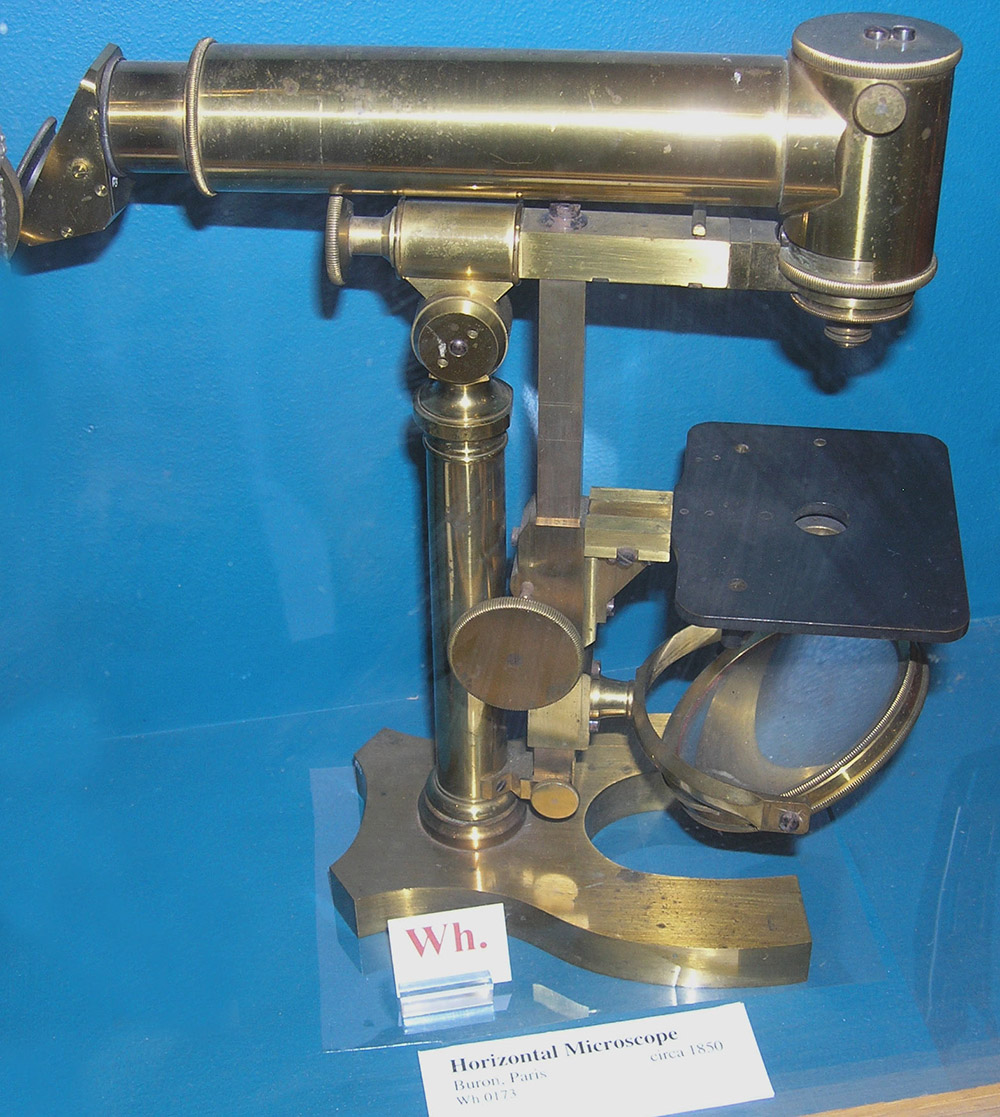
Figure 1.
A horizontal microscope signed by Nöel Buron. It is very similar to the case-mounted microscopes that are illustrated in Figure 2 (below). The foot resembles those of later instruments by Nachet, and may be a replacement. Adapted for nonprofit, educational purposes from a photograph taken at the Whipple Collection (photographer not known).

Figure 2.
(A) Illustration of Buron’s “Grand Microscope Universel”, from his 1844 catalogue.
(B) An unsigned microscope that appears to be an example of Buron’s model.
(C) Another example, signed by Widdifield and Co., Boston.
(D) Buron’s illustration, used by B. Pike Jr., New York, in his 1848 catalogue. Images of microscopes B and C adapted by permission from http://www.antique-microscopes.com/photos/universal.htm.
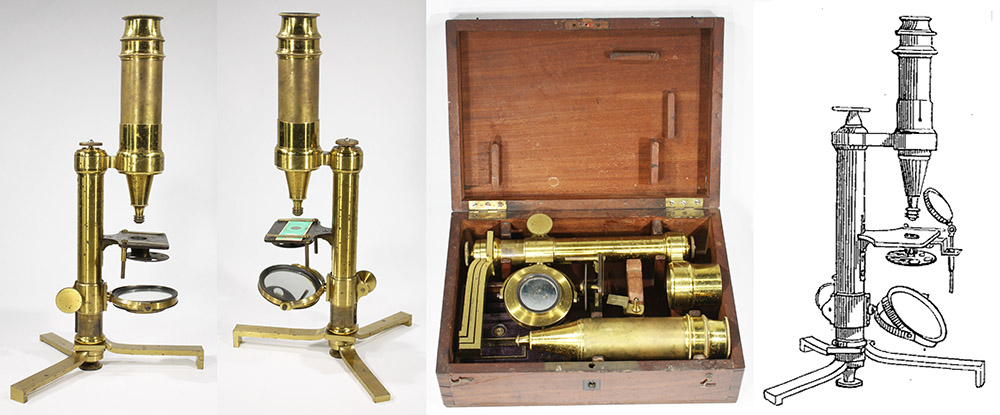
Figure 3.
"Grande Modele" by NoëlBuron, and illustration from his 1844 catalogue.
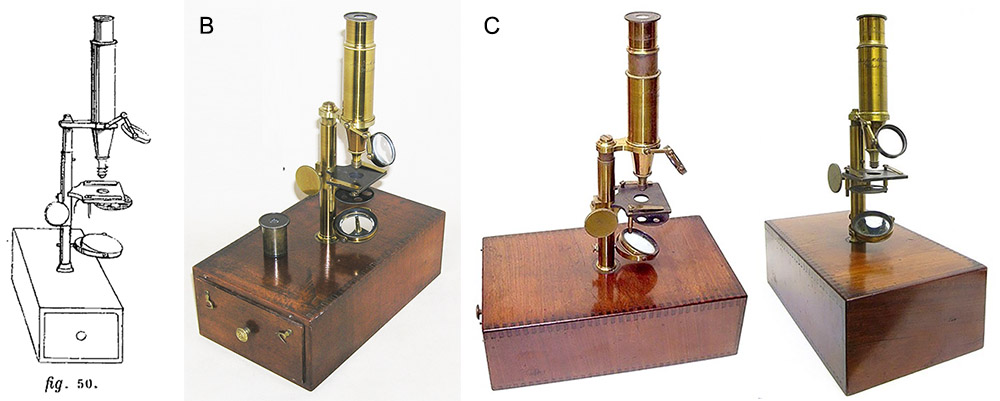
Figure 4.
An illustration of a case-mounted microscope from Buron’s 1844 catalogue. Note the substage wheel of stops and condenser lens mounted on the side of the body tube. (B and C) Surviving microscopes that are identical to Buron’s illustration, both signed by McAllister and Co., Philadelphia. Images of microscope C adapted by permission from http://www.antique-microscopes.com/photos/McAllister_Co.htm.
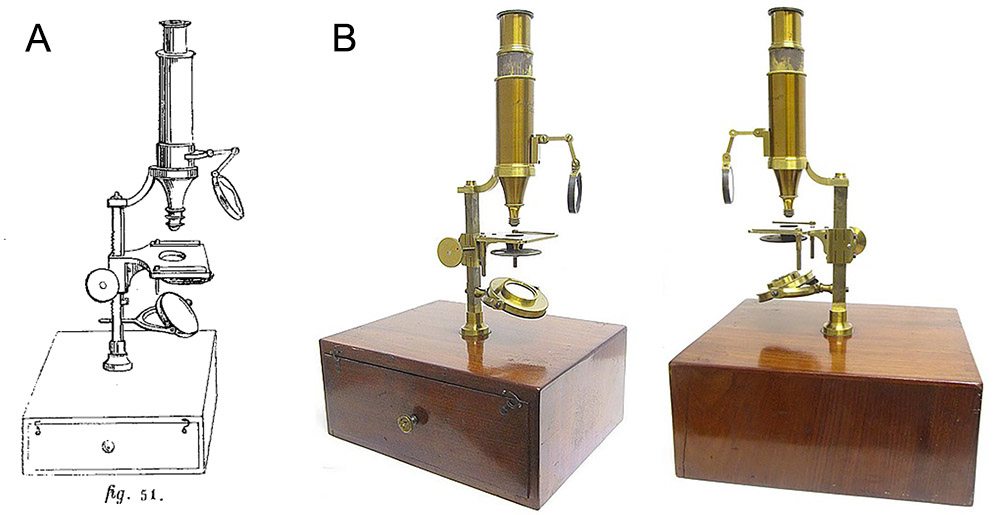
Figure 5A.
(A) An larger case-mounted microscope from Buron’s 1844 catalogue. Note the unusual curved limb.
(B) A surviving microscope that is identical to Buron’s illustration, signed by McAllister and Co., Philadelphia. Images of microscope B adapted by permission from http://www.antique-microscopes.com/photos/large_Buron-McAllister_microscope.htm.
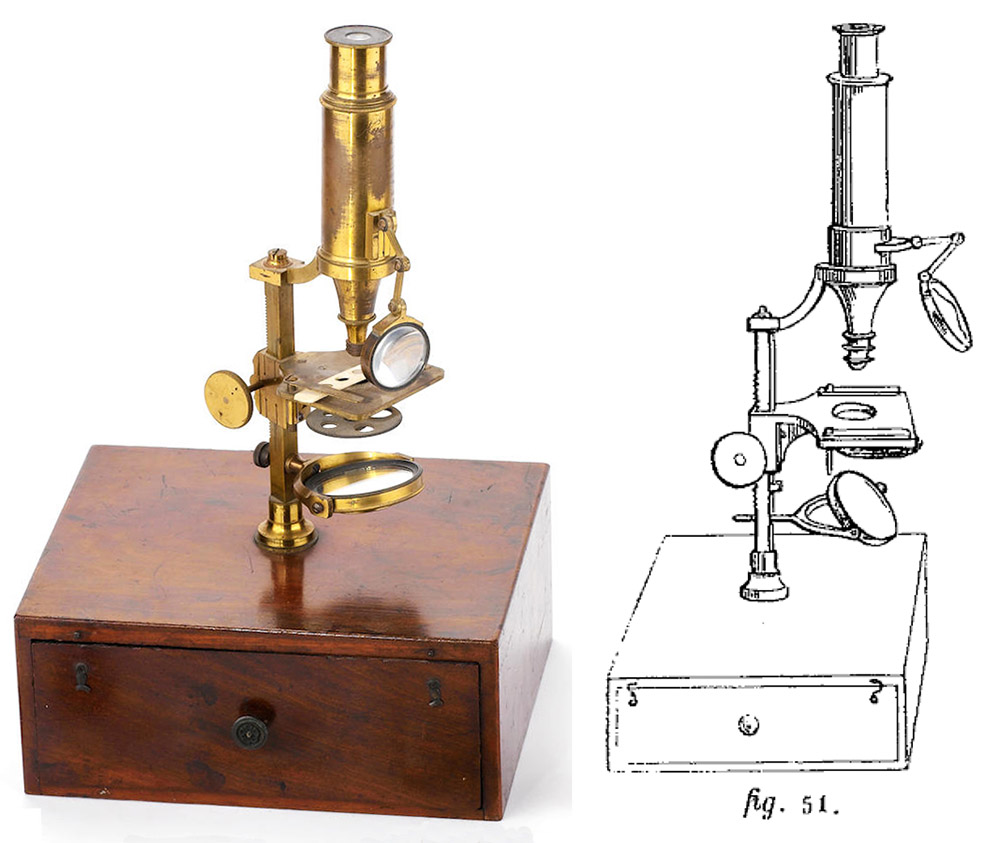
Figure 5B.
A case-mounted microscope that is signed "Nachet", yet has a body that is identical to number 51 in Buron’s 1844 catalogue, and the McAllister instrument shown in Figure 5 (above). Camille Nachet (1799-1881) began his microscope-manufacturing business in 1839, after having spent many years as a lens-maker for Charles Chevalier. A likely explanation for this instrument is that Nachet brought in microscope bodies during his early years, while producing the lenses himself. Indeed, the letterhead on forms used by Nachet in 1841 described the business as "Fabrique de Lentilles Achromatiques" ("manufacturer of achromatic lenses") https://www.meeusen.com/. Microscope image adapted for nonprofit, educational purposes from an internet auction site.

Figure 6A.
Drum-style microscopes from Noël Buron’s 1844 catalogue and two surviving examples. The eyepieces of both microscopes are marked with Buron's mark: the initials "NB" and a telescope. The example with the attached bull's-eye condenser and the rotating substage has a trade label indicating retail by J.W. Queen, of Philadelphia, which dates its sale to before 1858, when Queen formed a partnership and became "J.W. Queen & Company". Images from the author's collection or generously provided by Italo Tempera.
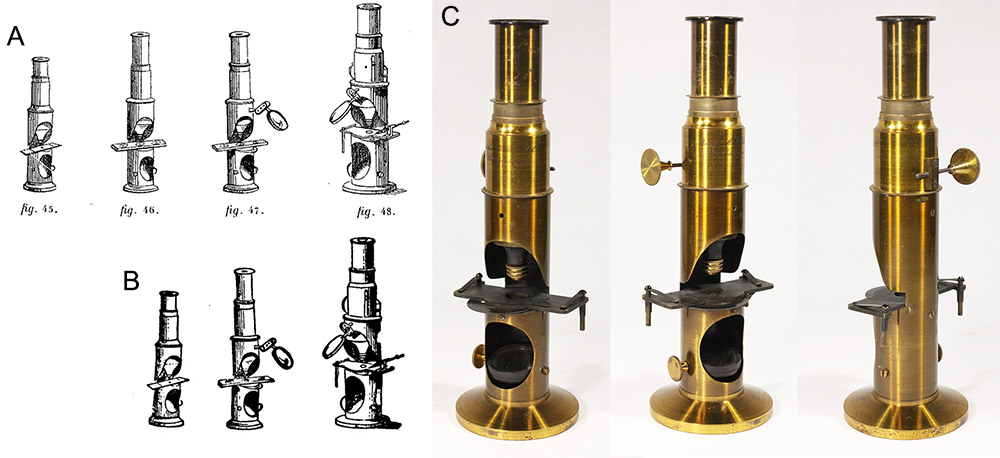
Figure 6B.
(A) Illustrations of drum-style microscopes from Buron’s 1844 catalogue.
(B) The same images, used in the 1855 catalogue of McAllister and Brother (successor to McAllister and Co.). This illustration is firm evidence of a business link between Buron and this American retailer.
(C) A drum microscope with rack-and-pinion focusing signed by McAllister and Co., Philadelphia. Note the extended, rectangular stage and substage wheel of stops. A bull’s-eye condenser was originally mounted in the hole above the stage. It is identical to microscope 48 of Buron’s catalogue.
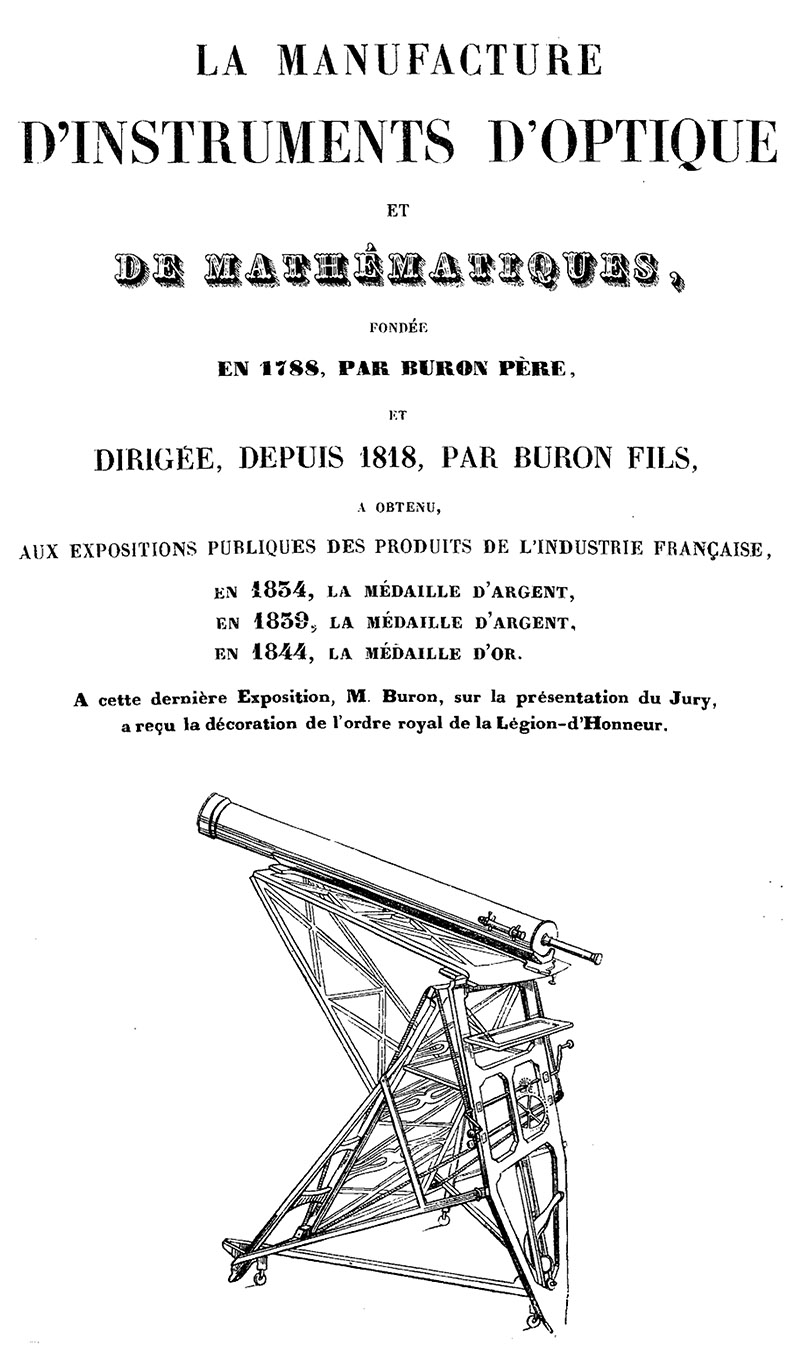
Figure 7.
Cover page of Nöel Buron’s 1844 catalogue. It notes several historical points, including the founding of the business in 1788 by father Joseph Buron, the acquisition of the business by Nöel in 1818, his 1834, 1839, and 1844 medals, and Nöel’s award of the Legion of Honor.
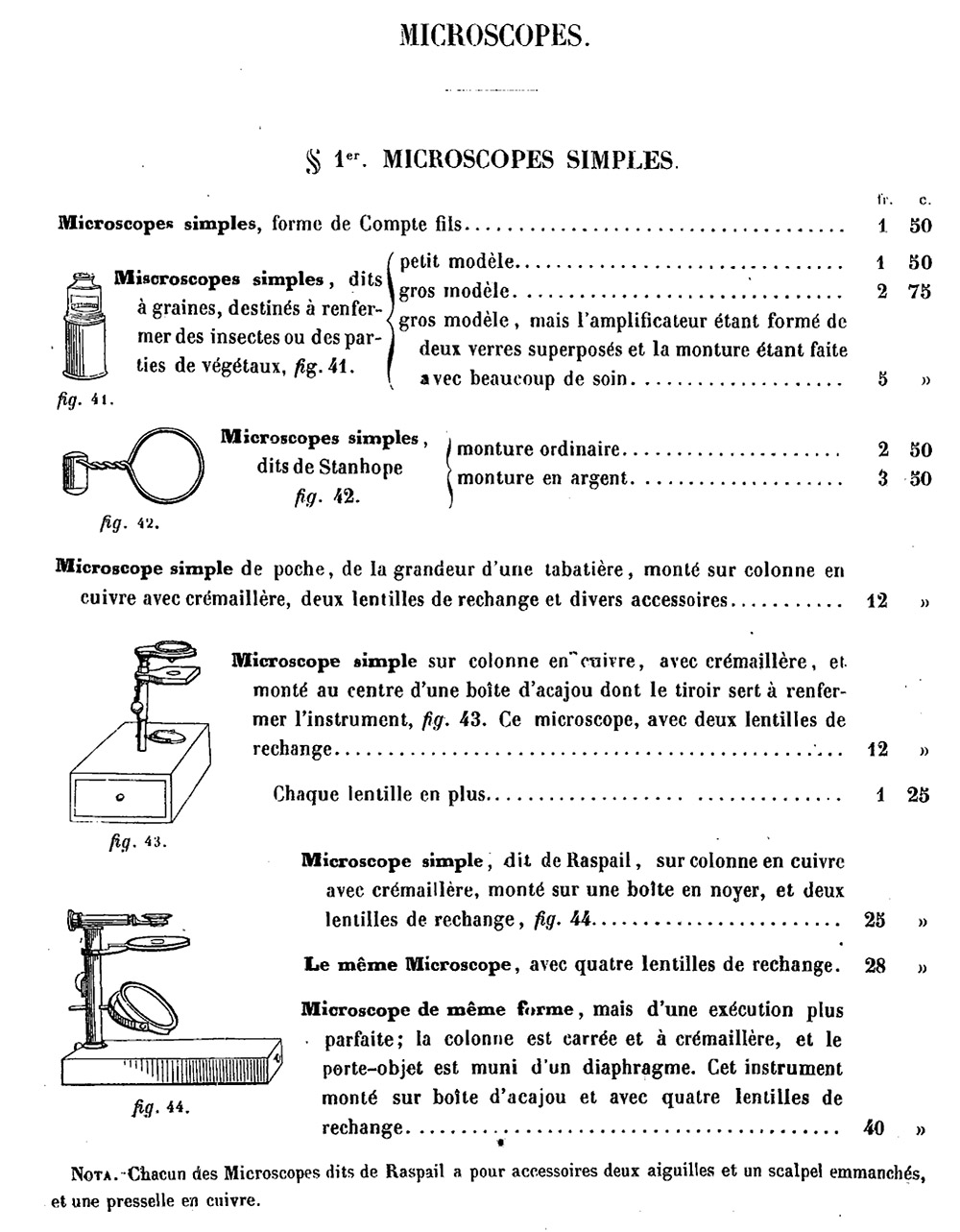
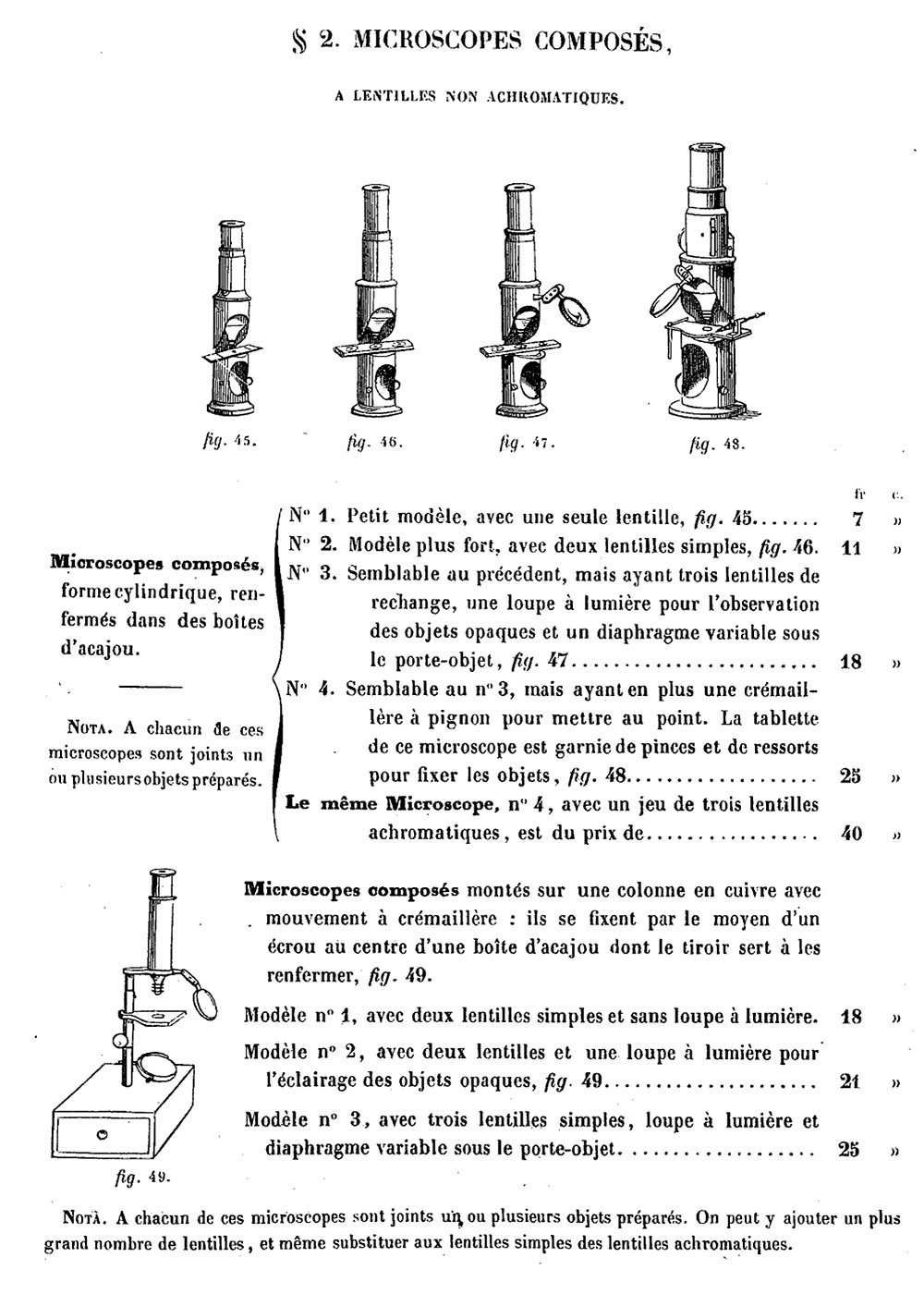
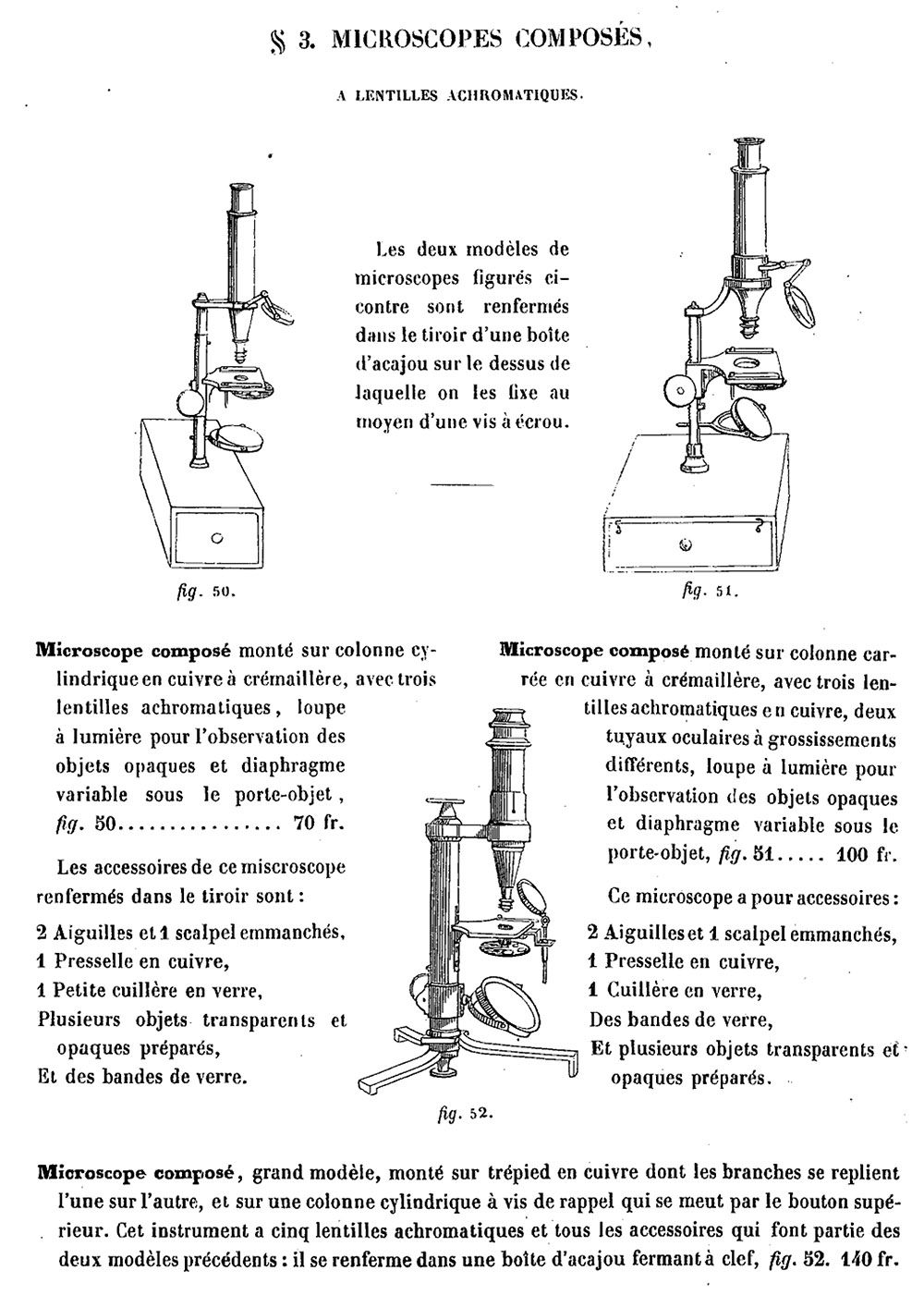
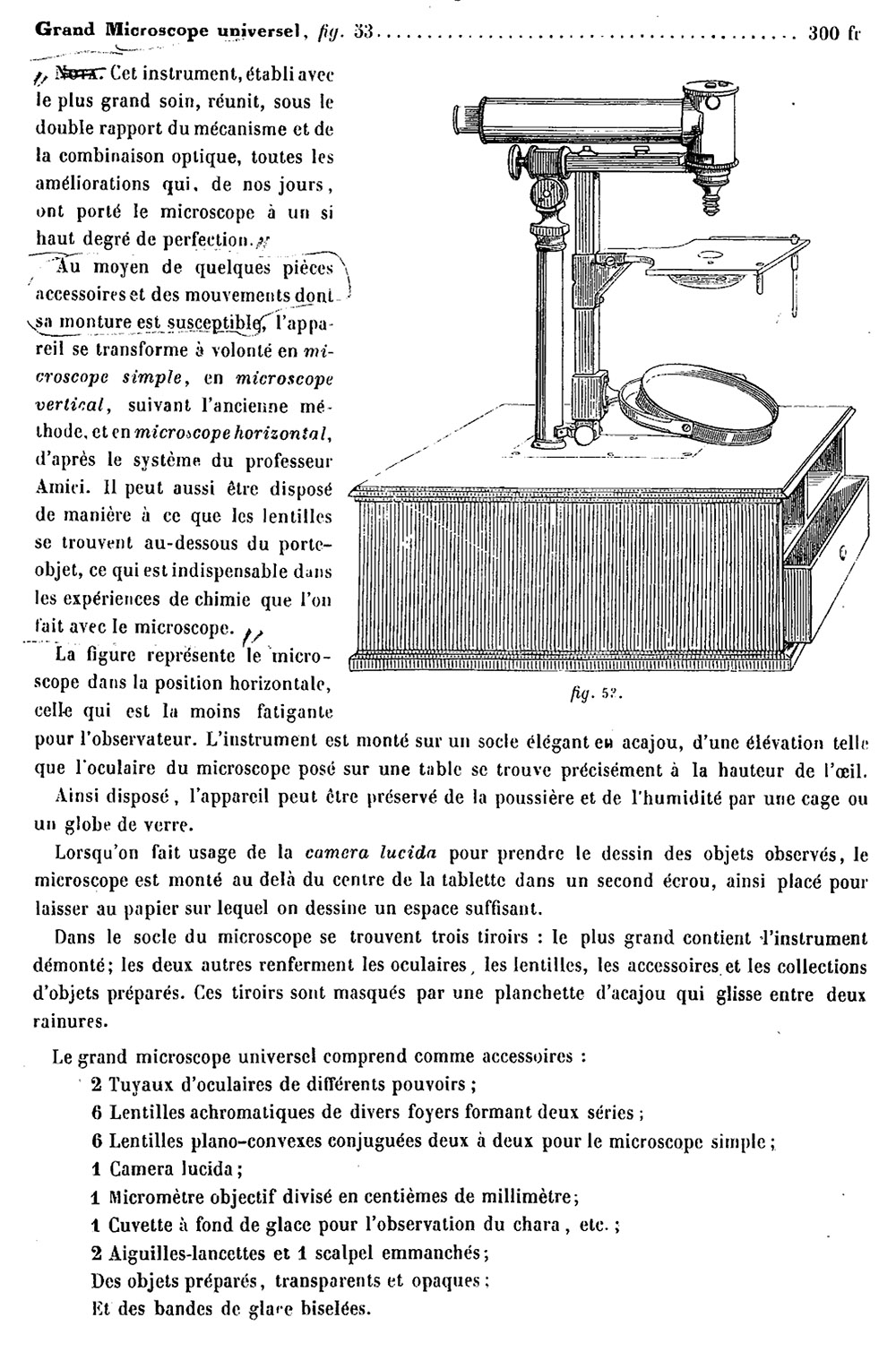

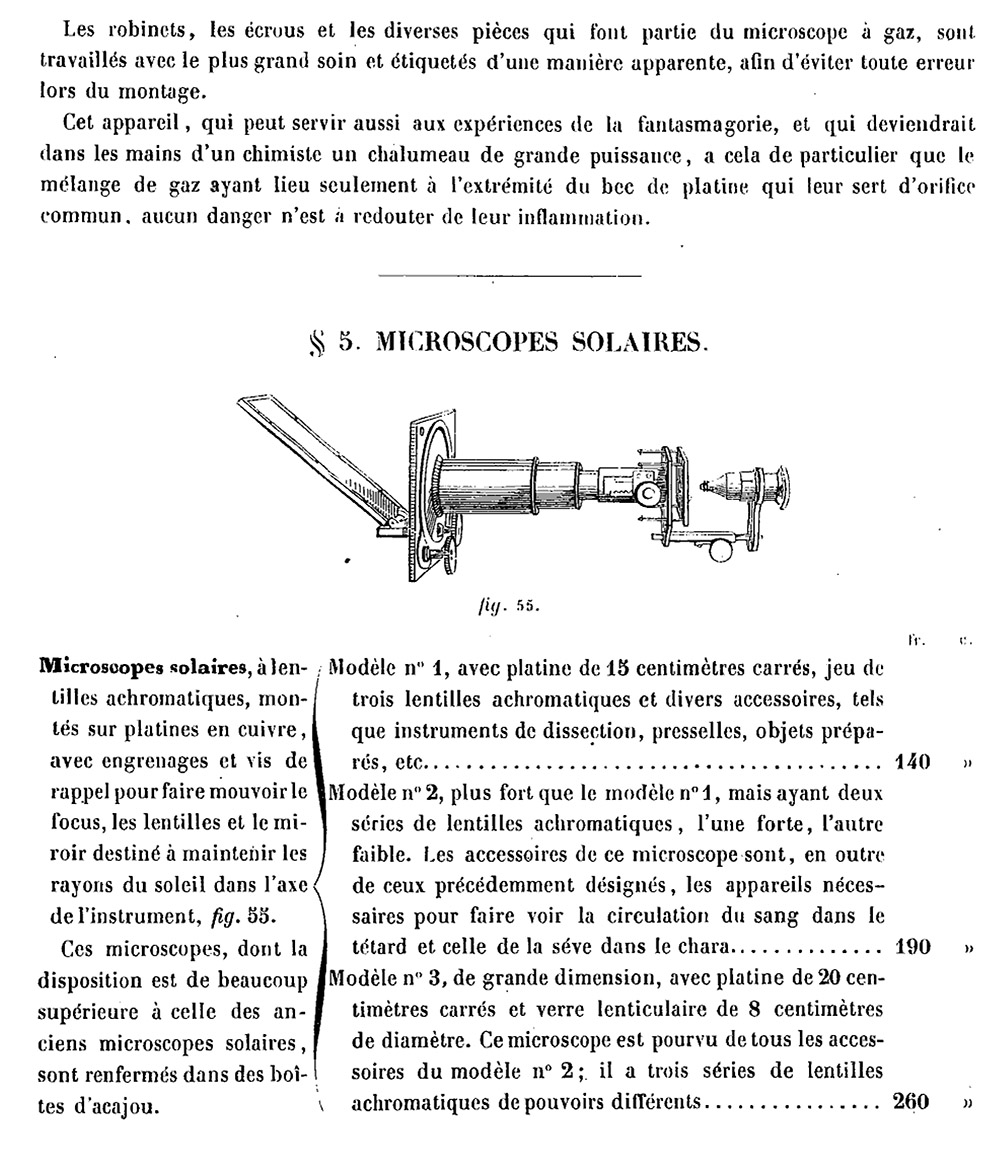
Figure 8.
Pages of microscopes from Buron’s 1844 catalogue.
The only firm date known about Nöel Buron’s lifespan is that of his death, August 5, 1856, which is recorded in a legal record of his death and on a memorial stone in his family’s burial crypt. The memorial states that he died at age 65. If that is precise, then he was born between mid-1790 and mid-1791.
Nöel’s father, Joseph Buron, established an optical and scientific business in 1788 (Figure 7). His products were described as “instrumens d'optique d'une bonne exécution” (“optical instruments of good make”; 1806) and “lunettes plaquées d'or et d'argent” (“gold and silver plated glasses”; 1809). Parisian business records from 1799 onward place the Buron shop on Quai de l’Horloge. A major center of optical and mechanical craft workers, he likely began his business on that street. Buron was at 37 Quai de l’Horloge in 1799, number 44 in 1805, and number 65 in 1806 - those changes may reflect renumbering, rather than physical moves. A partial record of Joseph’s memorial stone is available, which gives his age at death as 69 years old. Starting with an estimate of Joseph being roughly 30 years old at the time of Nöel’s birth, he would have been about 27 when he began his business, and born ca. 1760 and died ca. 1830.
Nöel took over his father’s business in 1818. This was noted in Le Nouveau Conducteur de l'Étranger à Paris, “Buron fils, Successeur de son père, Opticien, quai de la Cité, no. 21, ci-devant quai de l'Horloge, no 65. - Par Brevet d'invention, fabrique toutes sortes de lunettes de spectacle et de campagne, en cuivre et doublé d'or et d'argent, fait aussi télescopes microscopes, et la commission pour tout ce qui concerne l'optique. (Buron Jr., Successor of his father, Optician, Quai de la Cité, no. 21, formerly quai de l'Horloge, No. 65. - By Patent of Invention, manufactures all kinds of spectacles and campaign glasses, in copper and lined with gold and silver, also makes telescopes, microscopes, and on commission, everything related to optics)”. Note that Buron moved the business to 21 Quai de la Cité at the time of his acquisition.
In 1819, Nöel married Marthe Angélique Favière. Their marriage record indicates that either Nöel or Marthe was a godchild of Noël Jean Lerebours (1761-1840), also a noted manufacturer of microscopes and other optical apparatus. Marthe died in 1844, when only 44 years of age.
Nöel and Marthe had one child, Elisabeth Marguerite Françoise Buron. Her 1848 marriage was witnessed by the famed optician Nöel Paymal Lerebours (1807-1873), the son of Noël Jean Lerebours.
The Buron shop moved again during the mid-1820s. By 1826, he was at 53 Rue Sainte Avoie.
A Silver Medal was awarded to Buron at the 1834 Exposition Industrie Française. His telescopes were especially acknowledged, “M. Buron Fils, opticien breveté, rue Sainte Avoie, n°53. Cette fabrique, fondée depuis plus de quarante ans par M. Buron père, a pris un très-grand accroissement, principalement pour les longues vues, les lorgnettes de spectacle, les verres en général, et pour tous les instrumens d'arpentage et de dessin linéaire. Les lunettes de campagne et celles de marine, que ce fabricant livre depuis long-temps au commerce, ne le cèdent en rien aux lunettes anglaises; il est parvenu a en réduire tellement les prix, que, non-seulement il soutient avec avantage la concurrence des Anglais dans toutes les villes et les ports de mer où ils en-avaient jadis la vente exclusive, mais il les a forcés à renoncer a l'importation de leurs produits en France. C'est un service éminent fendu a cette branche importante de notre industrie” (“Mr. Buron, the son, patented optician, rue Sainte Avoie, n °53. Founded more than forty years ago by his father, Mr. Buron, this manufactory has greatly expanded, chiefly for telescopes, opera glasses, spectacles in general, and for all instruments of surveying and drafting. Campaign and marine glasses, which this manufacturer has long produced, are comparable to English glasses; he has succeeded in reducing the prices so much that he not only competes successfully with the English in all the towns and seaports where they formerly had exclusive sale, but he has forced them to give up importing their products into France. This is a distinguished service to an important branch of our industry”).
Buron moved yet again in the late 1830s, to 10 Rue des Trois Pavillons.
Buron received another Silver Medal at the 1839 exposition, and a Gold Medal in 1844. A description of the quantity and variety of baron’s display in 1844: “La place … était littéralement encombrée d'instruments de toutes dimensions dont aucun ne se répétait; indice assez plausible d'une grande fabrication …Ces produits, auxquels il était presque impossible de toucher sans risquer de faire crouler tout l'échafaudage qu'ils formaient, étaient ceux de M. Buron” (“The area ... was literally filled with instruments of every size, none of which was repeated; a visible sign of a great factory ... These products, which were almost impossible to touch without risking the collapse of all the stacks they formed, were those of Mr. Buron”).
Additionally in 1844, Buron made a Knight of the Legion of Honor.
That year also saw Buron’s publication of an illustrated catalogue, parts of which are shown here as Figures 7 and 8 (above). It contained a rather novel feature of including illustrations of Buron’s wares, so that purchasers knew exactly what they were buying, as opposed to the catalogues of many competitors that simply described items in words. A contemporary wrote, “Il se distingue des prix-courants ordinaires par une heureuse innovation qui, pour cette maison, remonte à 1838, et qui, depuis, a été imitée par quelques fabricants anglais. De jolies figures de chacun des principaux articles fabriqués par M. Buron se trouvent intercalées dans le texte de ce catalogue: et vos lecteurs se feront une idée plus exacte de rimmense variété de ces proiuits quand j'aurai ajouté que le nombre de ces figures s'élève à trois cent dix, et que, pour la plupart, le texte indique de quinze à vingt-cinq grandeurs différentes du même modèle. La plupart des marchands d'instruments d'optique et de mathémathiques des départements et de l'étranger, cumulent cette profession avec celle de quincaillier, d'épicier, de mercier, etc., etc., et sont presque toujours d'une ignorance complète, non seulement sur les qualités, mais encore sur l'usage et même le nom d'un grand nombre de ces instruments qu'ils ne tiennent pas habituellement dans leurs magasins. L'amateur qui veut se les procurer n'a d'autre ressource que de les faire demander à Paris. La commande, mal faite, amène fréquemment l'envoi de tout autre objet que celui qu'on désire, ou bien l'amateur, mal renseigné, demande un instrument moins utile qu'un autre, qui atteindrait mieux son but. Le catalogue de M. Buron remédie à tous ces inconvénients: l'acheteur, bien renseigné par les figures, peut désigner exactement ce qu'il désire, et le marchand, qui n'a qu'un numéro à inscrire dans sa commande, est tout-à-fait certain qu'elle sera parfaitement remplie, et qu'aucun mécompte n'en pourra résulter. Je ne crains pas d'affirmer que la publication de ce eatalogue est un véritable serviçe rendu à une importante industrie, mais surtout à la science, dont les adeptes, éloignés de Paris, pourront se procurer sans difficultés, et à coup sûr, les appareils dont ils auront besoin.” (“It differs from ordinary catalogues by a pleasant innovation which, for this house, dates back to 1838, and since that time has been imitated by some English manufacturers. Pretty figures of each of the principal articles made by Mr. Buron are included in the text of catalogue, so readers will have a better idea of the immense variety of these products. I counted the number of these figures to total three hundred and ten, and, for the most part, the text indicates from fifteen to twentyfive different varieties of each item. Most merchants of optical instruments and mathematics, both domestic and abroad, combine that profession with that of ironmonger, grocer, mercer, etc., etc., and are almost always totally ignorant, not only of the qualities, but also of the use and even the name of a large number of the instruments that they do not regularly stock in their shops. The amateur who wants to get such instruments has no other resource than to order them from Paris. A poorly made order frequently leads to the sending of an apparatus different from than the one desired, or the poorly informed amateur may order an instrument that is less useful than desired. The catalogue of Mr. Buron overcomes all these drawbacks: the buyer, well informed by the figures, can designate exactly what he wants, and the merchant, who has only one number to write in the order, is absolutely certain that it will be perfectly fulfilled, and that no error can result. I am not afraid to say that the publication of this catalogue is a real service to an important industry, but especially to science, whose followers, far from Paris, will be able to obtain what they need without difficulty, and with certainty”).
That description suggests that it is likely that McAllister, Pike, and other American retailers purchased wholesale microscopes from Buron because his catalogues illustrated exactly what the foreign dealers would receive. Those illustrations were also incorporated into the US retailer’s own catalogues, providing the same advantages as re��ceived by Buron (Figures 2 and 4).
Buron presented a broad display of his products at the 1851 London Exposition, and was awarded a Council Medal for his telescopes. The reports of the juries listed, “some excellent microscopes, for their price”, “a collection of glasses of 6, 8, 10, and 12 inches diameter, for dissolving views”, “various prisms”, “various sextants and octants in ebony and brass, furnished with coloured glasses to the number of five or seven, and with both direct and inverting telescopes. The sextants are divided to 10’, and subdivided by verniers to 10". The size and the construction of these instruments are in every respect like those made in England. Their divisions are good, and their price is low”, “a repeating theodolite with concentric circles, 8.7 inch diameter, divided to 10", and read by four verniers to 10". It is furnished with two telescopes of 17.7 inches in length, and apertures 1.2 inch. The vertical circle is 4.3 inches in diameter, and is divided to 30". Mr. Buron also exhibits several levelling instruments”, and “a telescope, the object glass of which is of rock crystal, 4 feet 2 inches in diameter, and 6 fe��et 3 inches focal length. Attached to the telescope is a finder, which embraces a field of view from 5° to 0°, and has cross wires, which, owing to the great illumination of the field, may be seen during the darkest night, and consequently the star brought into the centre of the field. On examining this instrument it was found to be good in every respect. It is fixed upon a very steady cast-iron stand, furnished with three small castors, brought into operation by means of rack-work when necessary to remove the instrument. … another telescope of about the same dimensions, which was found to be good. It is supported upon a stand, invented by the late M. Cauchois, the appearance of which is elegant, but as it compels the observer to stand during the time of observation, and as it is necessary to be moved entirely when large azimuthal angles have to be passed over, it is less convenient than the cast-iron stand before described. It is made of wood, which, though rendering it liable to be affected by variations of moisture, gives it the advantage of being lighter than one constructed of iron. … (and) telescopes of various sizes, provided with terrestrial and celestial eye-pieces, and mounted upon brass stands; also nautical and pocket telescopes. In the construction of his eye-pieces, M. Buron pays strict attention to the rules of M. Biot. Many of the portable telescopes were tried, and their performance was found to be very good; they are remarkably cheap”.
Nöel Buron retired and sold his business in early 1855. A notary record states, “Création d'une société en nom collectif entre Armand Charles Henri Lemaire, fabricant de lorgnettes, demeurant 24, rue de Saintonge, et Henri Leiner, voyageur de commerce, demeurant 11, rue de Mazagran, ayant pour objet l'exploitation d'un fonds de fabrication et de commission d'instruments d'optique appartenant actuellement à Noël François Joseph Buron, sous la raison sociale, Leiner et Cie, successeur de Buron, établie pour une durée de 9 ans, au capital de 100 000 francs, siège social situé 8, rue des Trois-Pavillons” (“Creation of a partnership between Armand Charles Henri Lemaire, maker of opera glasses, residing at 24 rue de Saintonge, and Henri Leiner, traveling salesman, residing at 11, rue de Mazagran, for the purpose of operating a business, manufacturing and commissioning optical instruments, currently owned by Noël François Joseph Buron, under the name, Leiner and Company, successor of Buron, established for a period of 9 years, with a capital of 100,000 francs, registered office 8, rue des Trois-Pavillons”). It is possible that Leiner and Co. continued to supply US and other retailers with wholesale microscopes, although little has been identified on that business. Leiner and Co. lasted through the mid- to late-1860s; by 1870 it had been acquired by J. Wemans and Co. Lemaire retained his original, independent business, and his opera glasses are frequently seen in auctions nowadays.
Nöel Buron died on August 5, 1856, at the age of 65. His memorial stone reads, “Ici repose Noël François Joseph Buron, ancien président du conseil des prud'hommes, chevaleir de la légion d'honneur, décédé à Paris le 5 août 1856, à l'âge de 65 ans. Tendre père, bon parent, il laisse sa fille et tous les siens inconsolables. Fabricant distingué, commerçant honorable, il emporte l'estime, l'affection et les regrets de tous ceux qui l'ont connu. Priez Dieu pour lui” (“Here rests Nöel François Joseph Buron, former president of the industrial tribunal, Knight of the Legion of Honor, died in Paris on August 5, 1856, at the age of 65 years. Tender father, good parent, he leaves his daughter and all his inconsolable. Distinguished manufacturer, honorable trader, he carries the esteem, the affection, and the regrets of all who knew him. Pray God for him”).
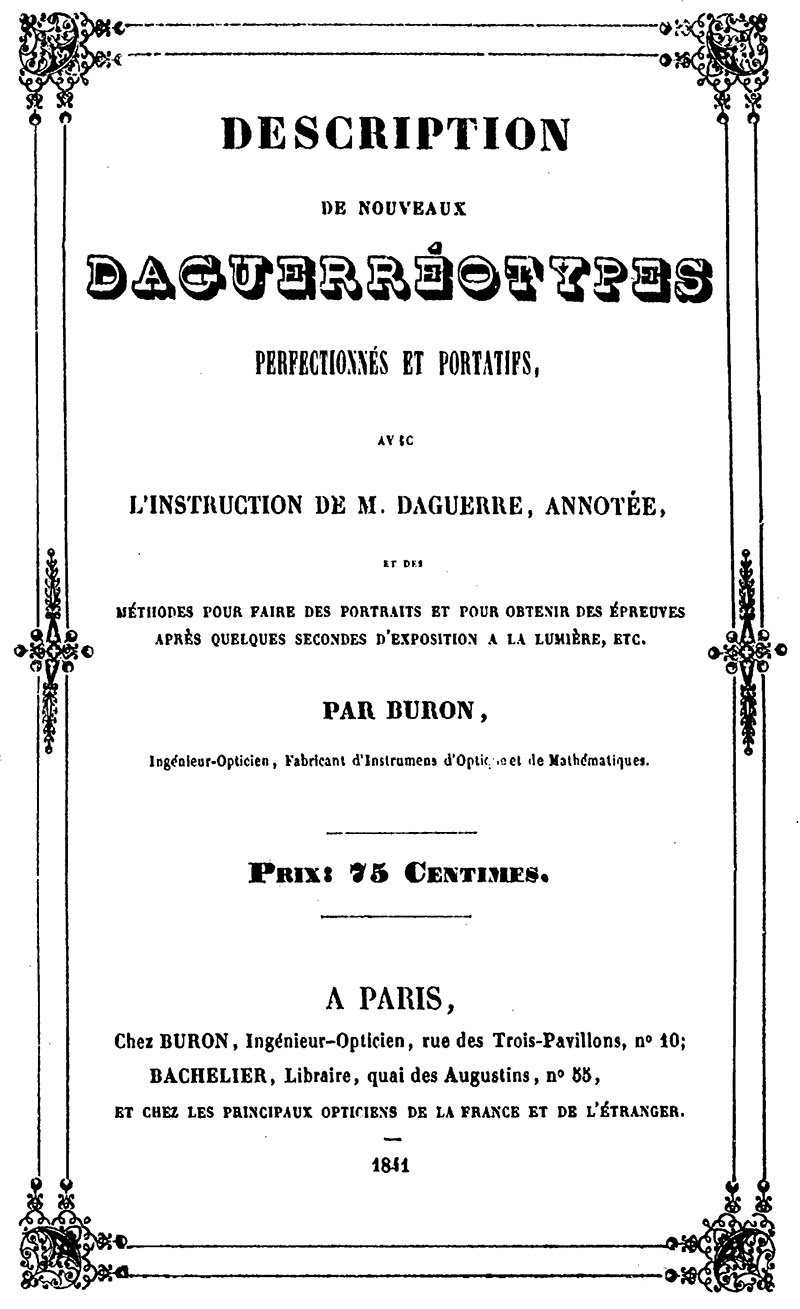
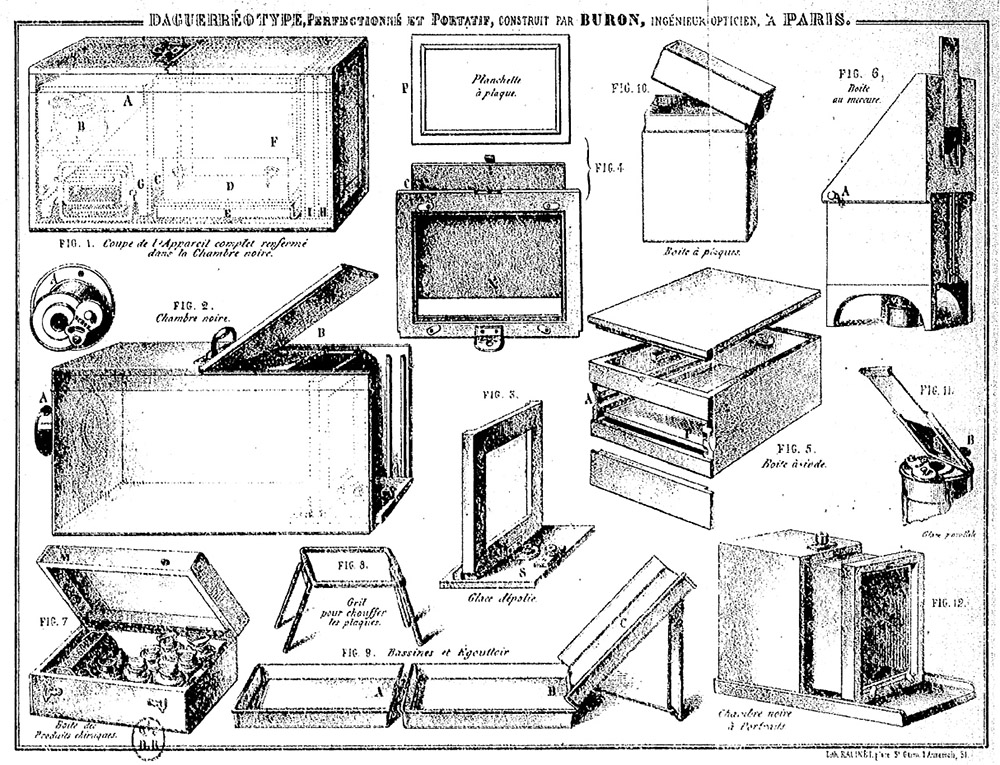
Figure 9.
Cover page from Buron’s 1841 booklet on daguerreotype photography, and illustrations of the apparatus that he produced.
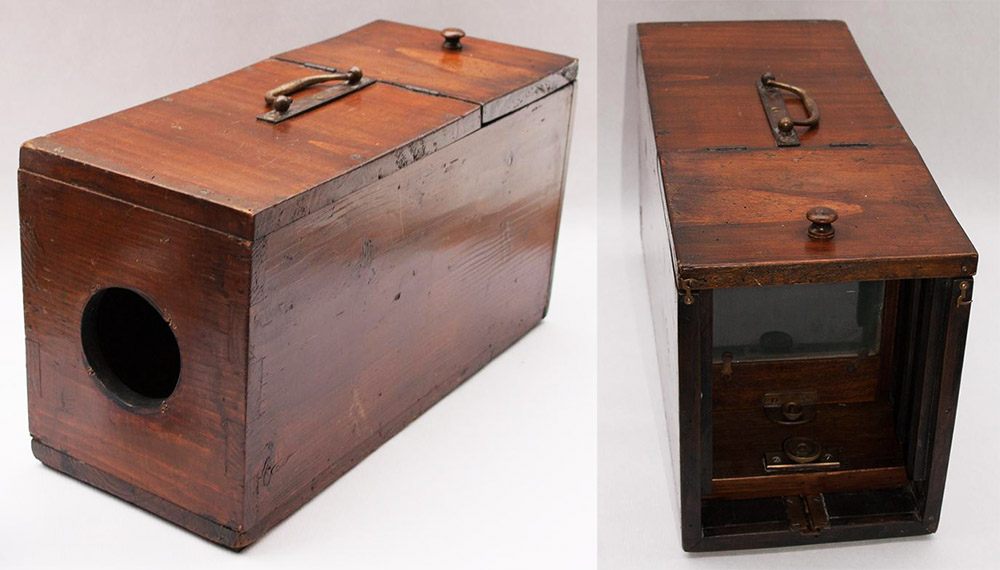
Figure 10.
A ca. 1841 camera that was made by Buron. Adapted for nonprofit, educational purposes from http://antiquecameras.net/buron.html.
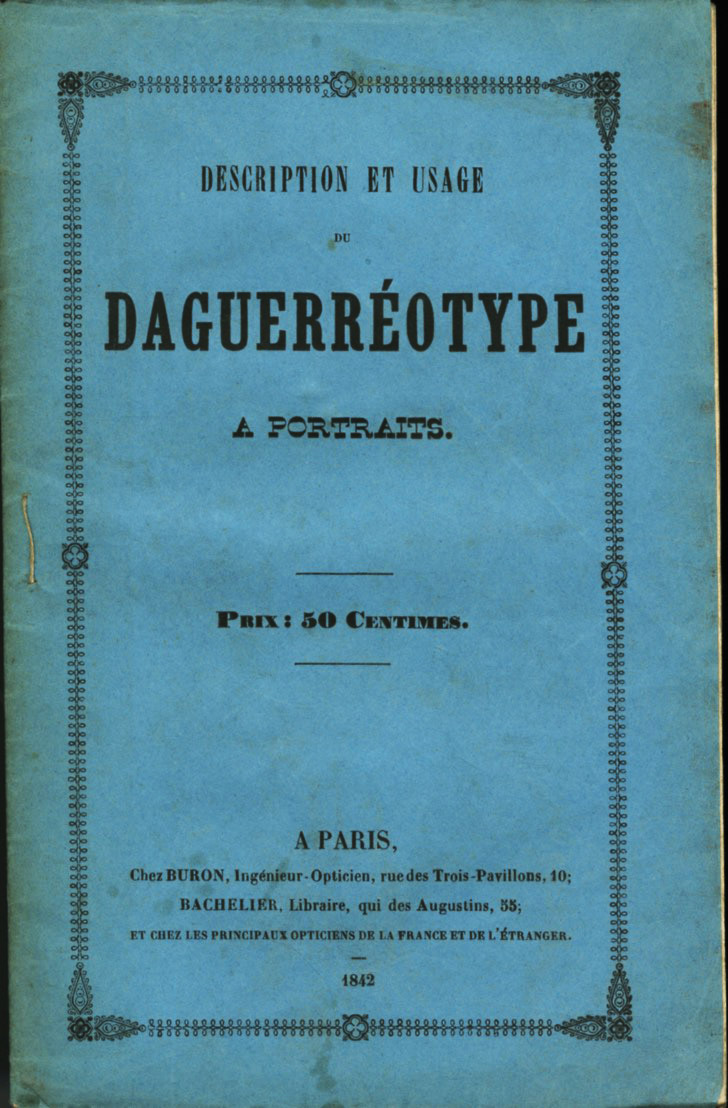
Figure 11.
Cover of Buron’s 1842 booklet on daguerreotype portraiture.
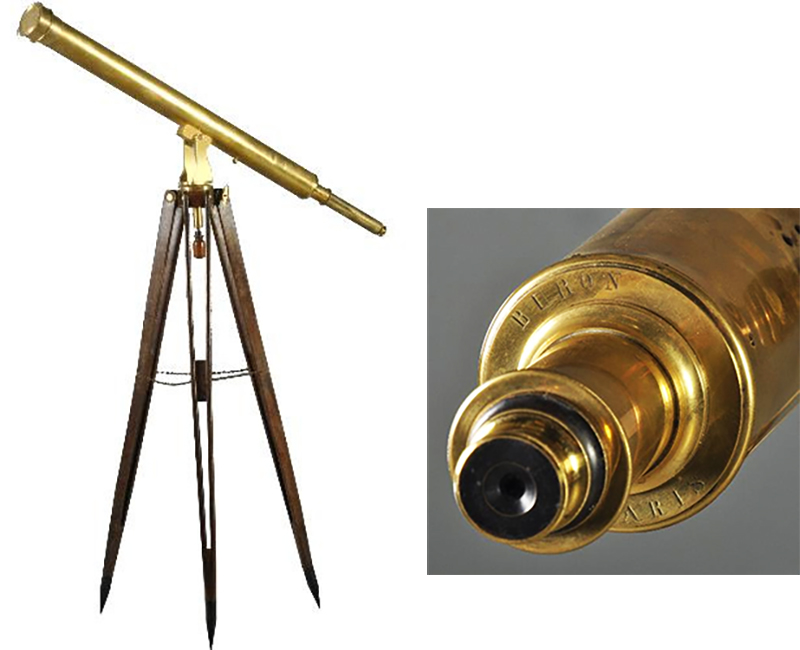
Figure 12.
A telescope by Buron. Adapted for nonprofit, educational purposes from an internet auction site.
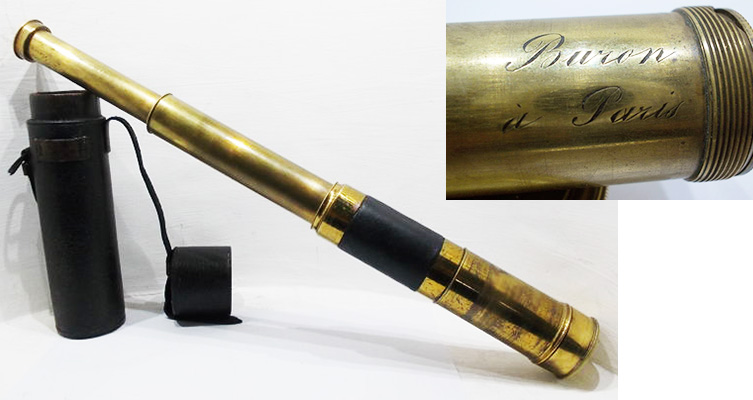
Figure 13.
A Buron hand-held telescope. Adapted for nonprofit, educational purposes from an internet auction site.

Figure 14.
A sextant by Buron. Adapted for nonprofit, educational purposes from an internet auction site.
Acknowledgements
Thank you to Allan Wissner for providing images of microscopes from his collection and for pointing the way to Buron, and to Joe Zeligs and Italo Tempera for sharing images and helpful insights.
Resources
Almanach du commerce de Paris (1799) “Buron, Q. de l’Horloge, 37 - P. Neuf”, page 237
Almanach du commerce de Paris (1805) “Buron, Q. de l’Horloge, 44 - P. Neuf”, page 118
Almanach du commerce de Paris (1809) “Buron, fabricant de lunettes plaquées d'or et d'argent, quai de l'Horloge, 65”, page 240
Almanach du commerce de Paris (1815) “Buron, quai de l’Horloge, 65”
Almanach du commerce de Paris (1820) “Buron fils, quai de la Cité. 21”, page 376
Almanach du commerce de Paris (1859) “Leiner et Cie, success. de Buron, manuf. d'instrum d'optique et de mathémat.; achats à commission, Saintonge, 43”, page 730
Almanach du commerce de Paris (1864) “Leiner et Cie, fab. d'instruments d'optique et pour les sciences, Saintonge, 43”, page 382
Almanach du commerce de Paris (1870) “Leiner et Cie (J. Wemans et Cie successeurs), commission en articles de Paris, Palestro, 5”, page 392
Buron, Noël F.J. (1841) Description de Nouveaux Daguerréotypes Perfectionnés et Portatifs, Avec l'Instruction de M. Daguerre, Annotée, et des Méthodes Pour Faire des Portraits et Pour Obtenir des Épreuves Après Quelques Secondes d'Exposition à la Lumière, etc., Buron, Paris
Buron, Noël F.J. (1842) Description et Usage de Daguerréotype a Portraits, Buron, Paris
Buron, Noël F.J. (1844) Prix-Courant de la Manufacture d'Instruments d'Optique et de Mathématiques, de Buron à Paris
Favière family tomb engravings, accessed through https://commons.wikimedia.org/wiki/File:P%C3%A8re-Lachaise_-_Division_42_-_Favi%C3%A8re_09.jpg
Marriage record of Noël François Joseph Buron and Marthe Angélique Favrére (1819) accessed though ancestry.com
Meeusen, Jeroen (accessed August, 2019) A collection of 19th century Continental microscopes and related items, https://www.meeusen.com/
Musée Industriel et Artistique ou Description Complète de l'Exposition des Produits de l’Industrie Française (1844) Vol. 1, page 3140
Notary’s record of the marriage of Noël François Joseph Buron and Marthe Angélique Favrére (1819) “Contrat de mariage sous le régime de la communauté de biens entre Noël François Joseph Buron, opticien, demeurant 3, rue du Milieu-des-Ursins, et Marthe Angélique Favière, mineure, demeurant chez ses parents, 11, rue des Lions-Saint-Paul. À signaler: en présence de Noël Jean Lerebours, opticien, parrain du futur”, accessed through https://www.siv.archives-nationales.culture.gouv.fr
Notary’s record of the marriage of daughter Elisabeth Marguerite Françoise Buron (1848) “Contrat de mariage sous le régime de la communauté de biens entre Louis Charles Bocquet, architecte, demeurant 58, quai de la Mégisserie, et Élisabeth Marguerite Françoise Buron, demeurant chez son père, Noël François Joseph Buron 10, rue des Trois-Pavillons. Mariage à la mairie du 8e anc. arrondissement de Paris. À signaler: en présence de Noël Marie Paymal Lerebours, opticien”, accessed through https://www.siv.archives-nationales.culture.gouv.fr
Notary’s record of the purchase of Nöel Buron’s business by Lemaire and Leiner (1855) “Création d'une société en nom collectif entre Armand Charles Henri Lemaire, fabricant de lorgnettes, demeurant 24, rue de Saintonge, et Henri Leiner, voyageur de commerce, demeurant 11, rue de Mazagran, ayant pour objet l'exploitation d'un fonds de fabrication et de commission d'instruments d'optique appartenant actuellement à Noël François Joseph Buron, sous la raison sociale, Leiner et Cie, successeur de Buron, établie pour une durée de 9 ans, au capital de 100 000 francs, siège social situé 8, rue des Trois-Pavillons”, accessed through https://www.siv.archives-nationales.culture.gouv.fr
Notary’s record of the death of Nöel Buron (1856) “Notoriété après décès de Noël François Joseph Buron, survenu en son domicile 16, rue de La Sourdière, le 5 août 1856”, accessed through https://www.siv.archives-nationales.culture.gouv.fr
Notices sur les Objets Envoyés à l'Exposition des Produits de l'Industrie (1806) “M. Buron, quai de l'Horloge, no. 65 : instrumens d'optique d'une bonne exécution”, page 288
Notice des Produits de l'Industrie Française (1834) page 101
Le Nouveau Conducteur de l'Étranger à Paris (1819) “Buron files”, page 334
Official Catalogue of the Great Exhibition of the Works of Industry of All Nations (1851) “443: Buron, Rue des Trois Pavillons, Paris. - Optical and mathematical instruments”, page 223
Reports by the Juries (1851) pages 252, 254, 264, 267, 271, and 275
Revue Scientifique et Industrielle (1844) Instruments de précision, pages 333-339
Wissner, Allan (accessed August, 2019) Antique Brass Microscopes, http://www.antique-microscopes.com/





















